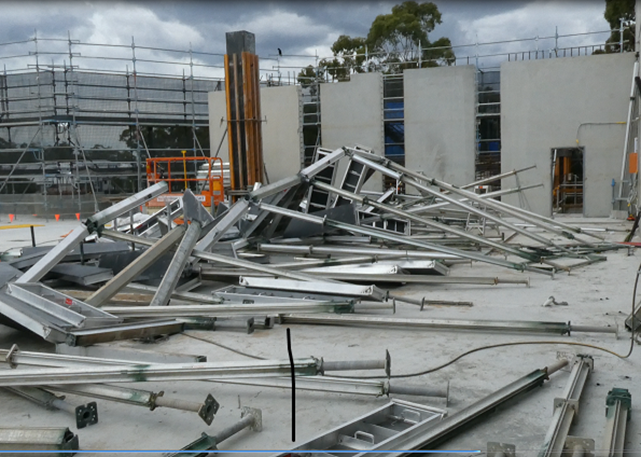Formwork collapse
Issued: 19/06/2023
Last Updated: 19/06/2023
Purpose
This safety alert discusses a formwork collapse and risk control measures that should be applied to help prevent formwork collapse.
Background
In April 2023, a 4.6 metre high modular formwork (falsework) system collapsed during erection. A scissor lift elevating work platform was being used to assist with the formwork erection, and overturned. Two workers in the scissor lift were injured, one seriously. Other workers were able to run away from underneath the falling formwork and narrowly missed being injured. Figure 1 shows a view of the collapsed formwork.

Figure 1 – Collapsed modular formwork
Contributing factors
The exact cause of the incident is being investigated.
In general terms, formwork systems can collapse for a number of reasons including one or more of the following:
- The formwork deck or the supporting structure is too weak to withstand loads during the erection phase or when concrete is poured (i.e., poor design).
- Inadequate bracing both during erection and when concrete is poured.
- Failure to follow the correct erection sequence so the structure remains stable.
- Defective components including damaged or corroded, or components of incorrect specification.
- Wind loading.
- Mobile plant colliding with the formwork – either within the formwork structure or externally.
- Premature loading of incomplete formwork or overloading during erection (i.e., from stacked materials).
- Being struck by loads lifted close to the formwork.
Action required
When erecting formwork systems, ensure:
- The design has been engineered to be strong enough to safely withstand all loads applied to the formwork including erection loads, concrete loads, and environmental loads (e.g., wind).
- For modular formwork systems, the manufacturer’s erection instructions are strictly followed. The manufacturer’s instructions should preferably include step-by-step diagrams that can be easily understood by formworkers.
- For modular systems, the bracing is added progressively at the correct stages according to the manufacturer’s instructions.
- For traditional formwork systems, they should be erected in accordance with the formwork designer’s instructions (i.e., the engineer’s instructions), so the system remains stable. This includes limiting screw jack extension as specified by the engineer, aligning timbers in U-heads correctly, and securing tops or bottoms of props. This information should be detailed on the formwork drawings.
- Where elevating work platforms (EWPs) are used in the erection, the EWP is the correct type and size to perform the work safely so that the unit can be safely manoeuvred through the formwork without contacting props or bracing. Typically, where EWPs are used, they will be relatively small scissor lifts and not boom type units. Prior to using the scissor lift, a close inspection of the scissor lift should be carried out to identify any parts of the unit that could potentially act as snagging points, (i.e., protruding brackets). A risk assessment should be carried out to verify the EWP is safe to erect the formwork. A spotter may be needed in some situations to help avoid the EWP contacting the formwork.
- Before erection takes place, ensure all formworkers have adequate training, are familiar with the formwork system and are adequately supervised.
- Before materials are lifted onto the formwork, ensure the formwork is strong enough to safely withstand the additional loading. This includes following the written instructions of the formwork designer.